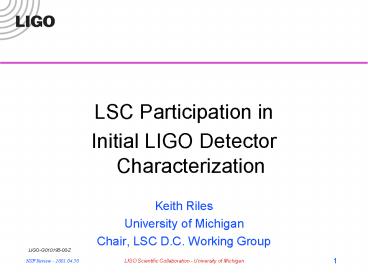LSC Participation in PowerPoint PPT Presentation
1 / 23
Title: LSC Participation in
1
- LSC Participation in
- Initial LIGO Detector Characterization
- Keith Riles
- University of Michigan
- Chair, LSC D.C. Working Group
2
Elements of Detector Characterization
- Commissioning
- Online Diagnostics
- Environmental Monitoring (hardware)
- Offline Data Monitoring
- Performance Characterization
- Transient Analysis (subgroup chair Fred Raab)
- Data Set Reduction (subgroup chair Jim Brau)
- Data Set Simulation
- Parametrized simulation (subgroup chair Sam
Finn) - End-to-End Model
3
Goals of Working Group on Detector
Characterization
- Quantify Steady-State Behavior of IFOs
- Monitor instrumental environmental noise
- Measure channel-to-channel correlations
- Quantify IFO sensitivity to standard-candle GW
sources - Characterization includes both description
correction - Identify transients due to instrument or
environment - Avoid confusion with astrophysical sources
- Identify correct contamination in data stream
- Diagnose and fix recurring disturbances
4
Examples of Ambient Noise
- Seismic
- Violin modes
- Internal mirror resonances
- Laser frequency noise
- Electrical mains (60 Hz harmonics)
- Coupling of orientation fluctuations into GW
channel - Electronics noise (RF pickup, amplifiers, ADC/DAC)
5
Examples of Transients
- Earthquakes, Trains, Airplanes, Wind Gusts
- Army tanks firing (!)
- Machinery vibration
- Magnetic field disturbances
- Wire slippage
- Violin mode ringdown
- Flickering optical modes
- Electronic saturation (analog / digital)
- Servo instability
- Dust in beam
6
Characterization Methods
- Measured optical, RF, geometrical parameters
- Calibration curve
- Statistical trends analysis (outliers,
likelihood) - Power spectra
- Time-frequency analysis
- Band-limited RMS
- Wavelets
- Principal value decomposition
- Non-linear couplings measurement
- Matched filters
7
Evolution of LSC Detector Characterization Efforts
- Initial work
- Developing infrastructure of online
characterization tools - Data Monitor Tool (DMT -- J. Zweizig)
- Diagnostic Test Tool (DTT -- D. Sigg)
- Developing software tools monitors for DMT
(broad effort) - Moving toward 2nd phase - two-pronged approach
- Investigations focussed on engineering runs
- 15 teams formed for E2 (Nov 2000)
- 13 teams formed for E3 (March 2001)
- Prelim reports from all E2 teams given at monthly
DetChar telecons - Final presentations written reports due at
March LSC meeting - Participation in four Upper Limits Working Groups
for E6 - Special session at March LSC meeting to identify
where help needed
8
Software Developed for the Data Monitor Tool
(DMT)
9
Where does LDAS fit in?
- Detector characterization used online for
diagnosis / warnings and offline for interpreting
data - Characterization conveyed downstream to LDAS via
meta-database and frame-contained constants - Meta-database entries (examples)
- Calibration constants and power spectra
- Environmental noise measures
- Cross-coupling coefficients (for regression)
- Line noise strength and phase
- Triggers (for veto or handle with care)
- Environmental disturbances
- Excess noise or unstable conditions
10
Other Detector Characterization Software Tools
from LSC
- Data Set Reduction
- Wavelet methods (lossless lossy) -- Sergey
Klimenko (Florida) - Data set summary -- Benoit Mours (Annecy/CIT) et
al - Data channel selection -- David Strom (Oregon)
- Data Set Simulation - Parametrized
- SimData package -- Sam Finn (Penn State)
- Time domain simulation tool (shot noise,
radiation pressure, thermal substrates,
suspensions, seismic) - Integrated into End-to-End Model
11
Engineering Run Investigations(E2 - November
2000)
12
Engineering Run Investigations(E2 - November
2000)
13
Engineering Run Investigations(E3 - March 2001)
14
Engineering Run Investigations(E3 - March 2001)
15
DMT Example Seismic Noise Monitoring
16
Engineering Run Results(Calibration studies)
c
c
c
c
- Scale set by absolute calibration
- Visible calibration lines (c)
- 30 calibration accuracy
17
Engineering Run Results(Line noise monitoring)
- AC Power line monitor Phase of 60 Hz
18
Engineering Run Results(Line noise monitoring)
- Tracking strength of injected calibration lines
- (One arm stable the other degrading with time in
lock)
19
Engineering Run Results(Line noise monitoring)
- Non-linearity signature - sidebands on
calibration lines
20
Engineering Run Results(Lock losses)
- Tidal correction disabled - periodic saturation
of coils
21
Engineering Run Results(Tidal modelling)
- Comparison of tidal derivative prediction with
data - (one free parameter) Differential Mode
22
Engineering Run Results(Tidal modelling)
- Comparison of tidal derivative prediction with
data - (one free parameter) Common Mode
23
Engineering Run Results(Transients)
- Airplane seen in E1 run (seismometer time/freq
plot)

